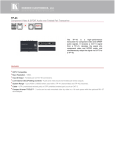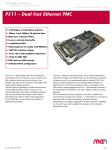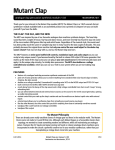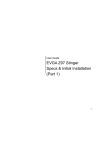Download Manual - Control Voltage
Transcript
The Mutant Machine dynamic analog percussion synthesis engine v1.05 hexinverter.net Thank you for your interest in the Mutant Machine (MM)! The Mutant Machine is a 29HP eurorack format synthesizer module. It requires the use of a eurorack format case and power supply to work. A MACHINE IS BORN The Machine began as a quest to create a rich-sounding eurorack snare drum synthesis module to complement the existing Mutant Drums. The project quickly became too large and costly to justify the module being capable only of snare drum sounds. So, the decision was made to learn from the architecture of the TR-909’s snare and kick circuits, in order to develop a module capable of generating multiple forms of analog percussion, and various other effects. Like the other Mutant Drums, the Machine has its roots in classic analog percussion synthesis. Even though it can create totally alien sounds, it still has the capability to deliver those classic 909 house snares and kicks if you want them. There are no microcontrollers in the Machine. The signals and waveforms are all generated by discrete components and ICs, for a distinctly analog sound, and user experience. FEATURES microcontroller-free analog percussion synthesis engine • unique Inverter Core oscillators form the MEMBRANE. Each analog oscillator has three waveforms to select from • capable of synthesizing everything from heavy-hitting bassdrums to classic 909-style snares and other complex timbres • modular design gives the Machine many auxiliary purposes, great for modular sound design of many varieties, and not just percussion • the SNAPPY section is comprised of a voltage controlled noise oscillator, for modelling the noisy part of drum timbres • both MEMBRANE and SNAPPY elements have an external input for replacing the built-in sound sources, opening up many avenues of possibility • 13 control voltage and audio inputs, for a fully modular drum experience • 7 audio and CV/gate outputs for maximum integration with other modules • dedicated outputs for each WAVE and NOISE oscillator mean you can use the Machine as a complex VCO in your system, when not synthesizing percussion waveform scanning feature generates complex timbres from analog waveforms • The MEMBRANE’s waveforms can be scanned through automatically by the wavescanner’s voltage controlled clock generator, or an external clock or VCO can be used • SCAN FREQ CV forms a unique form of timbre control, making the Machine act like a complex oscillator at its WAVES output • The ENABLE input allows you to gate the wavescanner on and off with a CV or gate signal TECHNICAL SPECIFICATIONS Width: 29HP | Depth: 30mm Current draw: +139mA, -115mA @ 12V 01.29.2015 Mutant Machine user manual v1.05 hexinverter.net electronics, 2015 PG1 ARCHITECTURE OF THE MACHINE The Mutant Machine is a dynamic analog instrument capable of generating a wide palette of sounds, ranging from various forms of analog percussion to complex drones and oscillations. To achieve this much variety, the Machine features two synthesis sections which are summed together at the final output: MEMBRANE and SNAPPY. Like the other Mutant Drums, the MEMBRANE and SNAPPY circuits began their mutation as classic analog percussion techniques and have been reimagined from the ground up for 21st century modular synthesis. The MEMBRANE forms the main body of the sound by way of two analog VCOs, and the SNAPPY section further adds to the timbre by contributing noisy elements to the mix. A noisy CLICK which occurs at the beginning of the SNAPPY sound can have its volume adjusted independent of the main decaying SNAPPY texture. The waveforms which make up the MEMBRANE can be selected manually by button press, or the WAVESCANNER can be used to automatically scan through the available analog waveforms. By modulating the frequency through which waves are scanned, unique, complex sounds are created. The SCAN FREQ works something like the timbre control on a complex oscillator. Experimentation is encouraged by the many modulation inputs and outputs available to you. The Machine features 8 CV and gate inputs for modulation as well as two external audio inputs, for bringing other modules into the Machine’s unique synthesis core. There are many audio outputs for maximum versatility, allowing you to use the Machine to create drones and alien timbres for use elsewhere in the modular analog system. MEMBRANE ARCHITECTURE The MEMBRANE forms the main body of the sound by way of two analog oscillators, each offering three waveforms to select from. The analog waveforms can be selected manually by button press, or the WAVESCANNER can be used to automatically scan through the available waveforms. By modulating the frequency which waves are scanned at, complex timbres are created. The scanner can be gated on and off via CV or gate with the ENABLE input. An external audio source can replace WAVE 1 in the signal path if a signal is patched into the WAVE 1 audio input. 01.29.2015 Mutant Machine user manual v1.05 hexinverter.net electronics, 2014 PG2 SNAPPY ARCHITECTURE The SNAPPY generator features a voltage controlled noise oscillator reminiscent of vintage 8bit computers. Small variations in pitch can produce dramatic changes in the overall sound produced by this unique oscillator. This section of the Machine complements the MEMBRANE by adding a decaying noise element to the mix. The decay is voltage controllable. The CLICK generator derives its sound from the same source as the SNAPPY, but its volume is adjusted independently. Should you tire of the internal noise generator, virtually any sound source can be injected into the signal path by plugging into the SNAPPY IN. 01.29.2015 Mutant Machine user manual v1.05 hexinverter.net electronics, 2014 PG3 MEMBRANE INTERFACE 1 Waveform level controls – adjusts the volume of the respective waveform. 2 Waveform selector – push the button to change the channel’s waveform. 3 Enable wavescan – use the switch or gate input to enable the wavescanner for all channels. 4 Enable wavescan for wave 2 – enables the wavescanner for waveform 2, if the wavescanner is enabled. 5 Wavescanner frequency – adjust the frequency of the wavescanner with this control and CV input. The CV input has an exponential response. Higher scan frequencies result in complex membrane timbres, while lower frequencies result in sequenced waveforms. The clock I/O is accessible for use elsewhere in the modular system. 6 Pitch – adjust the pitch of both membrane waveforms at once with this control and CV input. Like the rest of the Machine, this input is analog, so audio rate modulation is encouraged! 7 WAVE 2 detune – waveform 2 can be detuned up or down from waveform 1, across a wide frequency range. 8 Pitch decay – a percussive decay envelope can be applied to the pitch of both waveforms. Vary the amount and duration with the controls and CV input 9 Membrane decay – use the control and CV input to adjust the length of decay applied to the membrane. X WAVE 1 audio input – input an external sound source to replace waveform 1 in the membrane. The waveform 1 level control now adjusts the volume of the external sound source. 01.29.2015 Mutant Machine user manual v1.05 hexinverter.net electronics, 2014 PG4 SNAPPY INTERFACE 1 Snappy level – control adjusts the volume of the main noise element. 2 Click level control – controls the volume of a brief high frequency sound. 3 Snappy pitch – change the pitch of the snappy noise generator with this control and the CV modulation input. At the highest setting, pure white noise is generated with high frequency components. At the lowest pitch settings, the noise rate becomes sub-audio. 4 Snappy decay – the decay of the main noise element can be adjusted from a short snap to a long decaying swash of noise by way of this control and modulation input. 5 Snappy audio input – virtually any audio source can be injected into the snappy signal chain here. When nothing is connected, the volume of the internal snappy noise generator is adjusted by the control. 6 Noise output – the snappy noise generator is always available at this output, like a dedicated noise oscillator. The purple LED blinks in sequence with the frequency of the noise being generated. 01.29.2015 Mutant Machine user manual v1.05 hexinverter.net electronics, 2014 PG5













